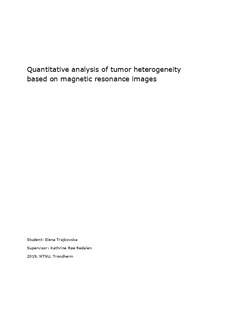| dc.description.abstract | Background: Solid tumors are commonly heterogeneous because they consist of cancer cells with different aggressiveness. In quantitative cancer imaging, such as magnetic resonance imaging (MRI), the heterogeneity will not be reflected in mean tumor values. The aim of this project was to develop a quantitative image-based tool that reflects tumor heterogeneity by using a machine learning approach with cluster analysis of MR images (T2-weighted and diffusion-weighted (DW) images) of 79 rectal cancer patients.
Materials and methods: The K-means algorithm is an unsupervised machine learning method that groups the pixel intensities based on similarity. In this project, a K-means clustering algorithm was applied to T2-weighted and DW MR images of malignant rectal tumors. The tumors were defined by delineations performed by two radiologists in the T2-weighted images. Associations between the resulting clusters and a set of tumor- and patient characteristics were investigated with the Wilcoxon rank-sum test. Progression free survival (PFS) was estimated to identify whether the presence of a certain cluster was linked to patient outcome. Differences in the results between the tumor delineations by the two radiologists were investigated.
Results: The results from the clusters defined based on T2-weighted images showed statistical significance (p<0.05) for the parameters from the “TNM” staging system. The assessed extent of the primary tumor and the regional lymph nodes after the CRT treatment. (p/ypT, p/ypN) and the difference in staging before and after CRT (ΔT) were correlated with the presence of some clusters. The DW images with b-values of 50, 100 and 500 s/mm2 demonstrated a significant association between clusters and tumor regression grade (TRG), which is a parameter reflecting the pathologic response to chemoradiotherapy. In the survival analyses, the DW images with b-value = 1000 s/mm2 showed that the most dominant cluster (largest homogenous region in the tumor) was related to poor survival. The combined data from the T2-weighted and DW images also indicated a significant association with PFS.
Conclusion: This project showed that K-means clustering of T2-weighted and DW MR images is a promising method to extract quantitative properties of tumor heterogeneity in rectal cancer. The results showed correlation to both pathologic treatment response and long-term survival. The combination of data from both T2-weighted and DW images improved the predictability of the outcome, so future studies may investigate different combinations of MR sequences for further improvements. | |
